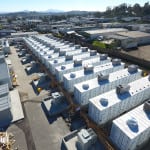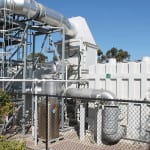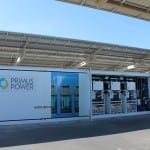Southern California Edison (SCE) signed contracts for more than 260 MW of energy storage resources on Nov. 5, among them what will be the largest grid-connected battery system in the world, a 100-MW facility supplied by AES Energy Storage.
Under its mandate from the California Public Utilities Commission (CPUC), SCE was required to sign contracts for at least 50 MW of transmission-connected energy storage resources by the end of this year. Instead, the flood of proposals spurred it to secure five times that amount. The total is just under half of the 580 MW of storage SCE must procure by 2020. Financial terms of the deal were not disclosed in the announcement.
This is by far the single largest move by a utility to expand its energy storage options, and it illustrates the boom in energy storage launched by the CPUC’s move last year. At the Energy Storage North America (ESNA) conference last month, Heather Sanders, director of regulatory affairs with the California Independent System Operator (CAISO) reported that CAISO is dealing with a “large influx” of storage project proposals—more than 2.1 GW, three times as much capacity as is required by the first phase of the mandate.
The state’s investor-owned utilities are not required to stop at the lower bound of the mandate, however, and SCE appears ready to move well beyond it with this group of contracts. The biggest winner is AES Energy Storage, which secured a contract to supply a 100-MW, 400-MWh Advancion li-ion battery storage system.
The project will be equivalent to a 200-MW flexible power resource, since it can supply both conventional generation as well as load-shifting and peak-shaving services. It will more than triple the capacity of the current largest battery storage system, AES’s 32-MW facility at Laurel Mountain in West Virginia.
The system will serve SCE under a 20-year power purchase agreement and will be built at AES’s existing Alamitos Power Center in Long Beach. It is scheduled for service by 2021.
“SCE’s selection moves California toward a clean, unbreakable power grid, taking advantage of energy storage for fast, flexible, emissions-free power,” said John Zahurancik, president of AES Energy Storage. “This contract marks the emergence of energy storage as a cost-effective alternative to peaking power plants for local power capacity and reliability.”
Zahurancik told POWER at the ESNA conference that AES is taking direct aim at traditional peaking generation with Advancion. “If you look at the kinds of things we built combustion turbines for in the past,” he said, “this is a better way to do it.”
SCE also secured another 161.1 MW of small-scale behind-the-meter storage resources, with 85 MW of that going to Millbrae-based STEM and 50 MW going to San Francisco–based Advanced Microgrid Solutions (AMS). STEM markets integrated li-ion energy storage primarily for commercial and industrial applications, while AMS is focused on supplying load-shifting service for utilities. The remainder will be thermal energy storage supplied by Glendale-based Ice Energy.
Energy storage sector observers were ebullient about the deal.
“This is a major win for behind-the-meter storage, demonstrating that this technology is a valuable tool for both utilities and their commercial and industrial customers,” said Janice Lin, co-founder and executive director for the California Energy Storage Alliance. “SCE is a pioneer in leveraging customer-sited storage for local capacity requirements and should be commended for its efforts to make storage an integral part of its operations.”
Lin told POWER at ESNA that she’s confident the CPUC and CAISO can handle the crush of applications and integrate new projects successfully. “The vetting process is robust enough to handle it.
The SCE contracts also included just under 1,700 MW of new gas-fired generation, 1,248 MW of which will be supplied by AES through upgrades and expansions at its Huntington Beach and Alamitos plants. The remainder will be peaking generation supplied by NRG Energy and the Stanton Energy Reliability Center.
—Thomas W. Overton, JD is a POWER associate editor (@thomas_overton, @POWERmagazine).










